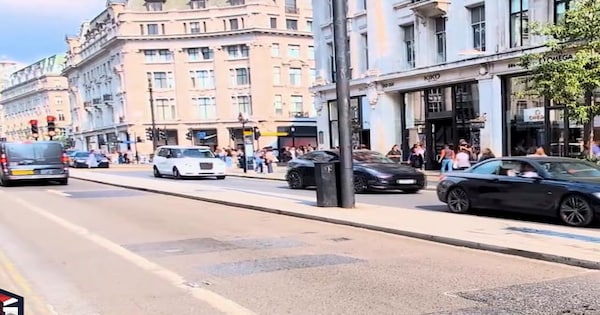What environmental and health benefits are expected to result from the traffic ban on Oxford Street?
London Mayor Sadiq Khan recently made a big announcement that has sparked a lot of discussion and debate. The Mayor revealed that there is a plan to implement a traffic ban on Oxford Street, one of the busiest and most iconic shopping streets in the heart of London. This move is aimed at reducing pollution and improving air quality in the area, but many are wondering what impact it will have on the British economy.
The traffic ban on Oxford Street means that all vehicles will be prohibited from entering the street from 2022. This decision has been met with mixed reactions. While some people support the move as a necessary step towards tackling air pollution and making the area more pedestrian-friendly, others are concerned about the potential negative effects on businesses and the economy.
The British economy relies heavily on retail and tourism, and Oxford Street is a major shopping destination that attracts millions of visitors each year. The traffic ban could have significant implications for businesses, transportation, and overall economic activity in the area and beyond.
Here’s what the traffic ban on Oxford Street could mean for the British economy:
Impact on Retail Businesses:
Oxford Street is home to numerous flagship stores, luxury boutiques, department stores, and other retail establishments. The traffic ban could potentially affect the footfall and accessibility of these businesses, leading to a decline in sales and revenue.
However, it’s important to note that the traffic ban is also an opportunity for retailers to re-evaluate their business models and adapt to the changing landscape. This could involve investing in online platforms, improving the customer experience, and exploring new marketing strategies to attract visitors to the area.
Tourism and Hospitality:
Oxford Street is a major tourist attraction, drawing visitors from all over the world. The traffic ban could impact tourism and hospitality businesses in the area, such as hotels, restaurants, and entertainment venues. Tourists may be deterred by the changes in transportation and accessibility, potentially leading to a drop in visitor numbers and spending.
On the other hand, the traffic ban could create a more pleasant and welcoming environment for tourists and locals alike, encouraging longer stays and increased spending in the area. This could boost the overall economy and positively impact businesses in the long run.
Transportation and Logistics:
The traffic ban on Oxford Street will undoubtedly have a significant impact on transportation and logistics in the area. Delivery services, public transportation, and private vehicles will need to adjust to the new regulations and find alternative routes. This could lead to increased costs, delays, and logistical challenges for businesses operating in the area.
However, the traffic ban also presents an opportunity to prioritize sustainable and eco-friendly transportation options, such as cycling, walking, and public transit. This could have a positive impact on air quality and contribute to a healthier and more vibrant urban environment.
Environmental and Health Benefits:
One of the primary motivations behind the traffic ban on Oxford Street is to address the pressing issue of air pollution in London. The ban is expected to significantly reduce emissions and improve air quality in the area, which can have far-reaching benefits for public health and the environment.
By creating a car-free zone on Oxford Street, the city aims to promote active transportation, reduce noise pollution, and create a safer and more enjoyable experience for pedestrians. These changes can contribute to a healthier and more sustainable city, attracting more visitors and enhancing the overall quality of life for residents and businesses.
Challenges and Opportunities:
While the traffic ban on Oxford Street presents several challenges for businesses and the economy, it also brings forth opportunities for innovation, adaptation, and growth. Retailers, hospitality providers, and transportation companies will need to pivot their strategies and embrace new ways of doing business to thrive in the changing landscape.
Ultimately, the success of the traffic ban on Oxford Street will depend on effective communication, collaboration, and strategic planning among all stakeholders, including businesses, local government, and the community.
the traffic ban on Oxford Street is a bold and ambitious initiative that aims to address pressing environmental and public health concerns in London. While there are potential risks and challenges for the British economy, there are also opportunities for positive change and long-term benefits. It remains to be seen how the implementation of the traffic ban will unfold and how businesses and the economy will adapt to the new reality.
By carefully considering the implications and opportunities of the traffic ban, businesses can navigate the changes and position themselves for success in the evolving landscape of Oxford Street and beyond.
The Most Visited City in the UK: London’s Traffic Ban
London is undeniably the most popular city in the United Kingdom, attracting hundreds of thousands of visitors daily who flock to the city for various activities such as shopping, dining, and entertainment. Recently, London Mayor Sadiq Khan made a groundbreaking announcement that traffic on Oxford Street is set to be prohibited. This decision has sparked discussions about its impact on the local economy, neighboring businesses, and residents, especially within the British Indian community.
Implications for Local Economy and Businesses
The prohibition of traffic on Oxford Street is expected to have significant implications for London’s economy. By transforming this bustling thoroughfare into a pedestrian-friendly zone, there will likely be increased foot traffic and a more conducive environment for leisurely strolls and shopping excursions. This could lead to a boost in retail sales as shoppers are able to explore with greater ease and comfort.
Furthermore, with less vehicular congestion and pollution in the area due to the ban on traffic, it is anticipated that there will be improved air quality which can positively impact public health. Additionally, this transformation may also attract new businesses looking to capitalize on the increased accessibility of Oxford Street.
Impact on Local Residents
For local residents living around Oxford Street – including those within the British Indian community –this decision holds both promise and potential challenges. The absence of noisy vehicles and exhaust fumes will undoubtedly make their immediate environment more pleasant. However, some may express concerns about potential disruptions during construction or adjustments required in their daily routines as they adapt to a car-free zone.
Looking Ahead
As plans progress toward implementing this major change in one of London’s most iconic areas, it is essential for officials to conduct thorough outreach efforts aimed at keeping all stakeholders informed about developments regarding transportation alternatives during this transition period.
In conclusion
The impending ban on traffic along Oxford Street marks an ambitious initiative by Mayor Sadiq Khan aimed at reimagining urban spaces through prioritizing pedestrians over vehicles. While its full impact remains uncertain at this stage., it undoubtedly signals an exciting new chapter for one of London’s busiest corridors – offering potential benefits not just for visitors but also for local businesses and communities alike.
SEO keywords: London City,Sadiq Khan,Oxford Street,British Indian community,economy,residents,popular city


